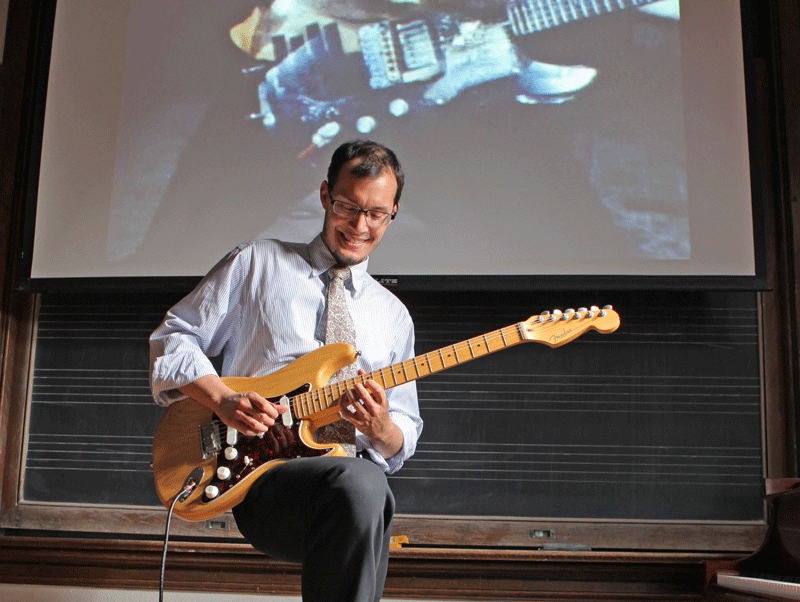History of Rock
Justin Patch, adjunct assistant professor of music, aims to change the way his students think about music, exploring why they choose the music they do and how it affects them.

What connects Chicago blues legend Muddy Waters to British rocker Mick Jagger? How did Elvis Presley change the world as we know it? What rock star would you like to have a chat with? These are some of the questions Adjunct Assistant Professor of Music Justin Patch is asking his students in a course called the History of Rock.
One of the first things Patch tells his students is that the name doesn’t quite capture what he’s teaching. “It’s more about analysis and emotion than it is about history,” he says. Patch’s protestations notwithstanding, students who take the History of Rock learn plenty about the history of American pop culture.
Patch begins the course by pointing out that the supposed birth of rock ’n’ roll in the 1950s has roots that reach back decades further, when the blues were born in the Deep South, then migrated to the industrialized cities in the North. And he contends the streak of rebellion that runs through rock helped to define the youth culture of the 1960s and most of the anti-establishment music—punk, grunge, hip-hop—that has followed.
Patch spends some time talking about such rock icons as Presley and the Beatles, not as historical figures whose biographies ought to be memorized, but as bridges that can help students gain a better understanding of how popular music has evolved. He asks them to focus on the passion their favorite music stirs in them. “I want you to think harder about the music you listen to, why you make the choices you’re making, and how it affects you,” Patch tells them.
Assignments include reading articles by music critics and listening to plenty of music from every era in the past 75 years, but the only textbook is the recently published The History of Rock ’n’ Roll in Ten Songs, by revered rock critic Greil Marcus, a former editor of Rolling Stone magazine. The students’ final project for the course entails creating their own music video of one of their favorite songs.
Patch’s students say the course is changing the way they think about music. Urban studies major Niccolo Porcello ’16 has been playing in rock bands since high school and recently launched a record label that is nurturing his current band, Aural Burrows, and six others. But now that he’s taking the History of Rock, Porcello says, he’s learning how little he knows about popular music.
“I’ve been listening to music all my life, but none of it was recorded before 1990,” he says. “I’m woefully uneducated about the history of rock, and if I want to pretend to be someone who wants to make a career in the music industry, I need a much better grounding in its roots. This course has given me a start in that direction."
“Justin is really good about explaining the web that connects many forms of music and the influences one form has on another,” Porcello adds. “He really illuminates those connections for us.”
Juliette Boberg ’16, an international studies major, says she decided to take the course after she worked for a music publisher in New York City last summer and began thinking about pursuing a career in the music industry. “I felt I needed more grounding in the progression of popular music, and this course is helping me understand it better,” Boberg says. “I was familiar with blues and early jazz, but Justin pointed out that the British invasion of the 1960s was rooted in this kind of music, and that was something I hadn’t thought about before. It’s not exactly a history course. It’s more about appreciating the music you like and understanding where it came from.”
Sheldon Wang ’17, who is majoring in economics and French, says he listened to some American music from the 1970s and 1980s while growing up in China and enrolled in the course to learn more about American and British music. “Justin has a way of putting things in perspective,” Wang says. “He wants us to be aware of how our music shapes us and gives us pleasure. It’s an unusual course—it’s about being happy.”
Patch says he was 24 years old when he had an experience that dramatized how diverse the music industry has become and how fast it’s moving. “I was giving a guitar lesson to an eighth grader, and I asked him what his favorite band was,” he recalls. “He told me it was S.O.D. (Stormtroopers of Death). I considered myself an expert in the field, and I’d never heard of them. That’s when I realized how wide the spectrum is. That’s why I want to help my students appreciate whatever music they listen to, and my course is evolving in that direction.”
